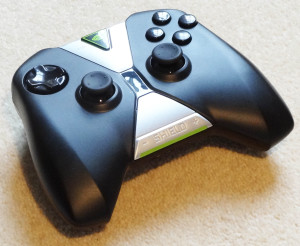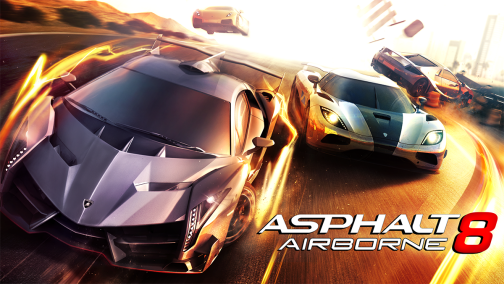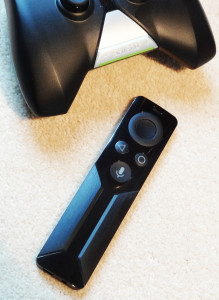Winding up the previous part of this nVidia Shield review I wrote “So now, I think, we’re at last ready to get on with Part 3—the actual review!”
We aren’t.
 WE’RE WAITING FOR THE GAMES CONTROLLER to be FedExed back from the nVidia European base in Holland, where it’s been on a hospital visit to get one of its buttons repaired. Well, of course, I won’t get back the one I sent; the RMA (Return Merchandise Authorisation) docket tells me that “The replacement unit may be a refurbished item or a new item, depending on availability”.
WE’RE WAITING FOR THE GAMES CONTROLLER to be FedExed back from the nVidia European base in Holland, where it’s been on a hospital visit to get one of its buttons repaired. Well, of course, I won’t get back the one I sent; the RMA (Return Merchandise Authorisation) docket tells me that “The replacement unit may be a refurbished item or a new item, depending on availability”.
The docket also provides the useful information that this controller is an RMAP2570 BLAKE SYSTEM BOM R (is this derived from the old BBC SciFi series “Blake 7”?). The nine days I’ve spent so far without it have been instructive, as, indeed was the initial button failure. Perhaps we should begin by talking about that.
Asphalt 8 on the nVidia Shield
As soon as I’d got the Shield video output working again (while still waiting for an explanation from nVidia about the HDMI failure and the rationale behind the “magical fix”) I naturally started putting it through its tests. Mission-critical among these was “Asphalt 8”, the racing game I was introduced to when I reviewed the Amazon Fire TV Box.
 Although the Shield would like to steer you in the direction of the paid-for and subscription games it offers, this freely downloadable racing game is the real winner for me. Asphalt 8 running on Amazon’s kit is pretty good, although the fastest races definitely strain the processor, with occasional frame jumps and even total freezes. The Shield’s processor and GPU combo is far superior, and you don’t need to get into engineering statistics to see this immediately. The Shield’s Asphalt 8 cars run smoothly at all the speeds I’ve managed to attain so far and the tracks come with snow and rain that the Amazon Fire TV box can’t provide. The nitro flares from the exhausts and clouds of dusts from cars drifting on the track ahead were a revelation uniquely provided by the Shield’s Tegra X1 quad-core processor and 256-core Maxwell architecture GPU.
Although the Shield would like to steer you in the direction of the paid-for and subscription games it offers, this freely downloadable racing game is the real winner for me. Asphalt 8 running on Amazon’s kit is pretty good, although the fastest races definitely strain the processor, with occasional frame jumps and even total freezes. The Shield’s processor and GPU combo is far superior, and you don’t need to get into engineering statistics to see this immediately. The Shield’s Asphalt 8 cars run smoothly at all the speeds I’ve managed to attain so far and the tracks come with snow and rain that the Amazon Fire TV box can’t provide. The nitro flares from the exhausts and clouds of dusts from cars drifting on the track ahead were a revelation uniquely provided by the Shield’s Tegra X1 quad-core processor and 256-core Maxwell architecture GPU.

The one-handed remote control costs around £30 extra, but there are bundled deals worth looking out for.
So I spent a good deal of time playing—er—testing Asphalt 8 on the Shield. Unlike the Amazon Fire TV Box, which is supplied with a rectangular remote control, the games controller being a forty quid cost option, the Shield includes the Blake controller in the price and nVidia is asking around thirty quid if you want the remote control. My Amazon Fire controller had comfortably taken me up to Season Seven level on the Fire TV Box, but now the A button was beginning to stick. Still workable for single pressing, but the slow recovery of what feels like a polyurethane dome-switch was making it problematic for Asphalt 8 rapid nitro-firing.
The moment I picked up the Shield’s gaming controller I was impressed with its heft, and the button action seemed a lot more positive right from the start. There are other important advantages over the Amazon device which I’ll come to later. This part of the story is about buttons.
Racing games are tough on controllers. Although you don’t need to slam down the buttons when braking or accelerating, in the excitement of the moment you just do. The Amazon controller’s button A started giving me problems around Season Six, but happily the flexibility of Asphalt 8 allows you to use alternative buttons for several of the functions, and Button B became my nitro trigger for Season Seven.
Unfortunately Amazon and nVidia use different Cloud storage systems for Asphalt 8, so my winnings accrued on the Fire TV Box meant nothing to the Shield, which had me starting again from scratch.
I wasn’t so lucky when a different button on the “Blake 7” controller for the Shield packed up around Season 3 (see box). The cross-shaped four button combo on the left hand side was what I was primarily using for steering, and mid-race I discovered I’d lost control of the wheel.
I subsequently learnt that the left hand thumb lever could also be used for steering, but there was one part of the Asphalt game that depended utterly on the West-facing part of the cross button. Without it there was no way of moving left while perusing the race options.
Half an hour later I was text-chatting to Rajath on the nVidia help desk. I went through the controller software reset routine with him, although it was pretty clear to us both that the problem was the hardware. Rajath very efficiently set up the RMA for me, and next day a FedEx courier turned up at my door to whisk the device back to base.
OK, hardware failures like this shouldn’t happen to a games controller within days of first use, but the particularly impressive thing about nVidia’s handling of the problem was that I wasn’t pulling strings through the PR company that sent me the device. I wanted to see how a regular customer (you, dear reader) would be treated. That treatment was responsive and swift.
Later
The Blake controller replacement has arrived, a day later than the original FedEx ETA, but the good news is that it’s brand new. No sooner had I charged it and paired it up to the Shield than an alert popped up to tell me a firmware update was available for both the controller and remote.
Now we’re back in business I’ll get on with the real reviewing in the next part. And I’ll start by telling you what I learned from not having the games controller.
